|
DT Research LT330
Pioneering tablet computer experts launch a timely trio of fully-rugged high-performance 360-degree convertible laptops with antimicrobial enclosures
by Conrad H. Blickenstorfer
Share on:



It may look like it's all smartphones and tablets these days, and those have certainly revolutionized life as we know it in more ways than we ever thought possible. But laptops are far from done just yet, and they may never be replaced. Having a full, solid, reliable mechanical keyboard remains at the very center of productivity in many places, and that includes not just the desktop but also vehicles and many other venues.
So San Jose, California, based DT Research, known as a noted purveyor and manufacturer of high quality information appliances including rugged mobile computing devices and medical computing solutions for vertical markets, has now introduced the company's first-ever line of rugged convertible laptop computers. And with anti-microbial enclosures no less. In this article we're presenting one of the company's three new LT300 Series machines, together with our assessment of where it fits in and what it can do.
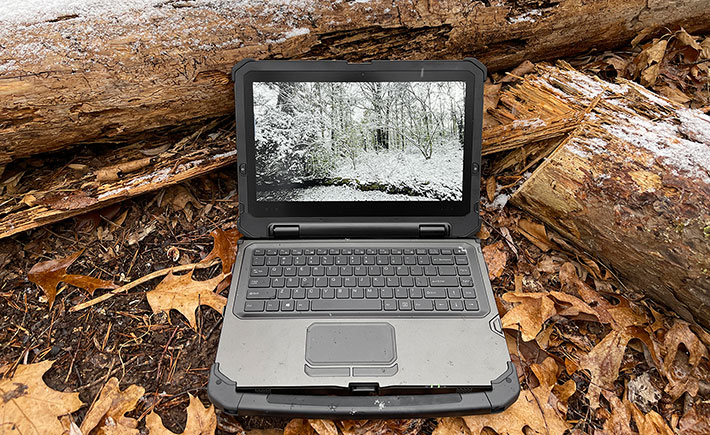
What, exactly, is a convertible laptop, and a brief look at its history
DT Research calls its (to the best of our knowledge) first-ever laptop computer a convertible laptop. Convertible as in you can use it as a conventional standard laptop computer, and you can also use it as a tablet. With tablets having become part of our lives, both personal and in business, offering both laptop and tablet functionality in one device certainly has appeal.
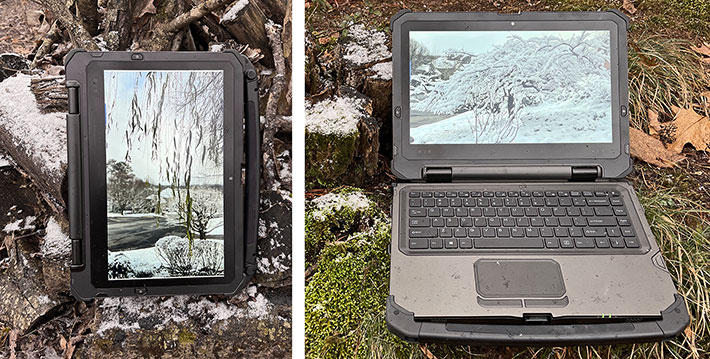
The convertible laptop concept isn't new. In fact, the first such design goes all the way back to 1992. The GRiD convertible used a single hinged arm that connected the rear of the notebook to the midpoint of the back of the screen, allowing the display to lay flat on top of the keyboard. IBM, too, offered convertible laptops as part of their early 1990s ThinkPad lineup. The mid-1990s also saw elegant Windows CE-based convertibles such as the Vadem Clio "SwingTop" whose display was supported on two hinged arms that connected the rear corners of the notebook to each side of the mid-point of the screen. Japan was an innovator back then: Panasonic, NEC, Fujitsu and Sharp all offered various convertible laptop designs. The page image below — from a proposal we once made to Microsoft for a Tablet PC Magazine — summarizes all those historic convertible approaches.
 With the launch of Microsoft's Tablet PC initiative in 2001 came the swivel screen convertible design where the laptop screen had a single hinge that could be rotated 180 degrees, leaving the screen facing upwards. Notable examples were the Acer TravelMate and the Toshiba Portege. The rotating hinge became popular in several markets and examples, such as the Getac V110, are available to this day. With the launch of Microsoft's Tablet PC initiative in 2001 came the swivel screen convertible design where the laptop screen had a single hinge that could be rotated 180 degrees, leaving the screen facing upwards. Notable examples were the Acer TravelMate and the Toshiba Portege. The rotating hinge became popular in several markets and examples, such as the Getac V110, are available to this day.
Ever since the very beginning of laptop convertibles, the question was whether it made sense to combine these two concepts — the laptop and the tablet — into one product. Did convertibles provide the best of two product types, or did they succeed in neither? For example, did convertibles make for very heavy tablets on the one side, and overly complex and more expensive tablets on the other?
The result of that discussion was the emergence of 2-in-1 hybrids. The Compaq Concerto with its detachable keyboard was a mid-1990s example of such a design. Others followed, and the 2-in-1 hybrid saw a resurgence in recent years, becoming one of the fastest growing tablet categories. 2-in-1 designs, however, also had their pros and cons, usually centering around the fact that they were "top-heavy" with a light keyboard and a much heavier tablet/screen part that also contained the computer.
As far as rugged laptops goes, they've been around for a quarter of a century as well. Rugged laptop pioneer Panasonic's Toughbooks now have competition from Getac, Dell, Durabook and others. DT Research is entering this potentially very lucrative market just as the traditional rugged laptop is undergoing transformations. For many years, those were big, heavy machines with tall 4:3 aspect ratio screens. In the last few years, those are increasingly replaced by lighter, more modern designs with wide-format displays. And with tablet unit sales now approaching laptop unit sales it's no surprise that many, including rugged laptop marketleader Panasonic, now hedging their bets with 2-in-1 designs.
DT Research's entrance into the rugged laptop market
Above we described the rugged laptop market the new DT Research LT300 line of convertible laptops is born into. Robust, durable laptops that can take a beating are still in much demand by police departments, government agencies, various industries, and everyone who needs a computer with a real, solid keyboard that is part of the computer, a reliable, integrated keyboard with real keys with real tactile feedback.
The question then becomes how one breaks into a well established market. Does one copy existing products and features? Does one beat pricing? Does one examine the competition and then try to go one better?
DT Research took a different approach, one that shows that they really thought this through. And here's the gist of their approach:
- Big screen: Instead of competing head-on with a particular competitor product, they did it their way, using and building on their strengths. Those include leading-edge performance, built-to-order configurations, and highest quality.
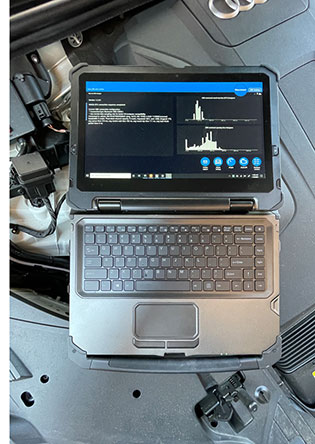 Big performance: DT Research concluded that in rugged laptops one size doesn't fit all. And so even their initial laptop line comes in three display sizes, 11.6, 13.3 and 15.6 inches. We've only examined the 13.3-inch model so far, but assume the family shares most of the technology. Big performance: DT Research concluded that in rugged laptops one size doesn't fit all. And so even their initial laptop line comes in three display sizes, 11.6, 13.3 and 15.6 inches. We've only examined the 13.3-inch model so far, but assume the family shares most of the technology.
- Big battery: The major rugged laptop players are currently competing on full ruggedness at the lowest possible weight. DT Research decided not to compete there and simply built their machine their own way, which includes considerably higher weight. That comes with benefits such as a maximum of 182 watt-hours of total battery capacity!
- Keyboard that works: Due to the longer product and purchase lifecycles, performance obsolescence is the bane of rugged laptops. So DTR went pretty much all out with their new laptops, giving them high-end Intel 10th generation quad-core and even hexa-core chips, without fan!
- Truly useful 2-in-1: DT Research built on their existing expertise. There is, for example, much of the DNA of the company's existing DT340T tablet in the new LT330.
- Truly useful 2-in-1: DT Research uses new and unconventional technologies. Two examples are their lightweight but quite efficient magnetic protective port covers, and also a double-jointed hinge design we haven't seen before.
The latter, especially, is interesting. Its double-jointed, integrated hinge addresses two issues that have long bedeviled 2-in-1 hybrid designs. First, it allows a true convertible design without being flimsy. And second, as an integrated design it eliminates not only the top-heaviness of 2-in-1s, but also connection and connection reliability issues between two components.
The flipside of this approach, of course, is bulk and weight. One could see that as a necessary evil of a convertible approach. I think DT Research saw it differently. They felt that for conventional laptop use, even a convertible should feel 100% like a sold laptop, and not something vaguely awkward, like so many 2-in-1s are. And I think that DT Research sees touch and tablet functionality no longer as simply replacing a touchpad or a mouse, but fully taking advantage of tablet software functionality, which today often exceeds speed and ease of use of mouse-based software. So, yes, the LT330 makes for a very heavy tablet, but, hey, if one needs a light tablet to carry around, DT Research offers many of those. The LT330 is for those who want a real laptop and also a convertible that allows taking full advantage of touch software.
Below you can see what it all looks like and how it can be used:
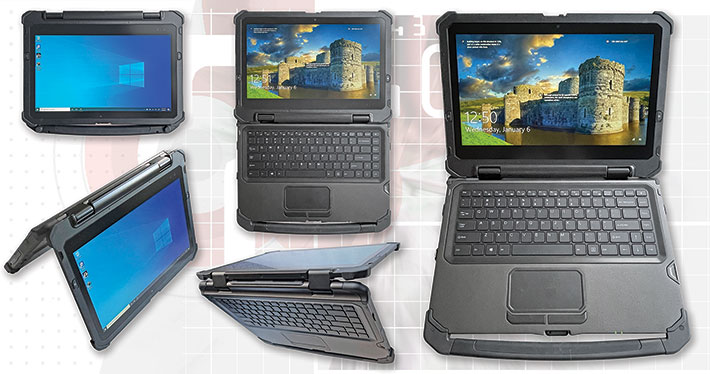
DT Research came up with a no-nonsense and very practical solution. The LT330 is a rugged laptop without compromises. Unlike some of the often alarmingly flimsy twisting and rotating convertible hinge solutions we've seen in the past, the LT330's double-jointed hinge system is solid as can be, and one won't even notice it when using the device as a laptop.
This solution eschews the Wow! factor of some past convertible solutions in favor of simple, solid functionality. Use it as a laptop or use it as a tablet. Sure, you can also use it in easel mode to make presentations to a couple of colleagues or customers without having to reach over the keyboard, but by and large, no tricks here.
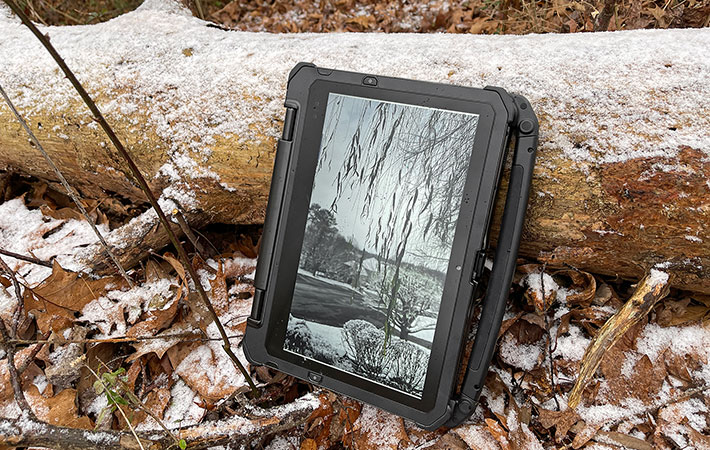
Taking a closer look at the DT Research LT330 convertible laptop tablet
After all the above discussion of the background of convertibles and all the pros and cons of various designs, let's take a look at the machine itself. The LT330 looks like a regular rugged laptop through and through. The 13.3-inch screen on our LT330 review model measures the same diagonally as full-size rugged laptops have for ages. The modern 16:9 wide-format aspect ratio, integrated carry handle and overall design and coloring makes it look much like its major competition, those being the Getac B360, Dell Latitude 5424 or Durabook Z14I.
Subtle clues, however, signal that this is more than just a standard laptop. Like the tablet-style glass that extends past the perimeter of the actual LCD and the lack of a raised bezel, both hallmarks of a tablet design. There are also hardware buttons for power and display to the left and right of the screen. In a conventional laptop they'd be on the keyboard case.
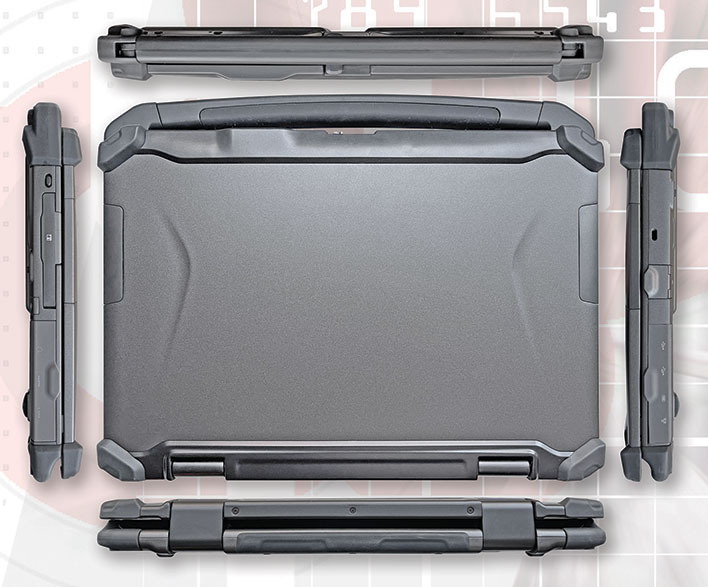
The LT330 sports the understated elegance and instant conveyance of quality common to DT Research machinery. Style follows function here, but it does so with great attention to detail. Unlike Panasonic Toughbooks with their almost trademark course silver powder finish, DTR's is more subtle. The powdercoating of its magnesium-aluminum alloy housing is subtle, like the metallic color of an expensive automobile. The rubber bumpers, one of the hallmarks of all rugged laptops neither draw undue attention to themsleves, nor are they integrated int the design to the extent of diminished functionality.
Just looking at it, you can't tell the LT330 is anything other than a rugged laptop. Its side views are very much laptop form-follows-function. The ports are sized and designed to get the job done. All three of the new LT330 line are fanless designs, so there are are no air intakes and exhausts. With the DT340T tablet, DT Research offered a discrete graphics option that added a fan, but the specs show no such option for the convertible laptops. The corner rubber guards are designed to provide maximum protection while being neatly integrated in the overall design.
DT Research has a lot of experience in designing medical computing gear with anti-microbial properties. With frequent cleaning and disinfecting now all but mandatory, they used this expertise and gave the LT300 enclosure materials anti-microbial properties as well.
This being a convertible laptop, DT Research moved some of the controls from the computer case to the keyboard case. This includes the power/sleep button and the night vision button. The latter toggles between display off and 20 nits, perfect for night use, but a bit too easy to inadvertently trigger during the day. The keyboard has display brightness controls, but since those aren't easily accessible in tablet mode, DT Research added silk-screened brightness up/down to the margin around the LCD. Those, as well as a couple of touch-related controls are very faint and not easy to see.
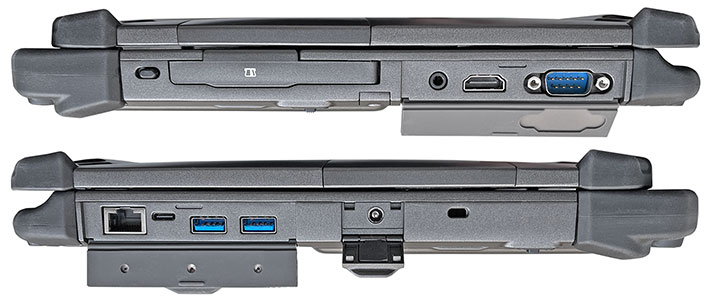
The images above show the right and left sides of the LT330 convertible laptop with the hinged protective covers open. The magnetic covers work surprisingly well, sort of like strong refrigerator magnets.
On the left side (bottom picture), the LT330 has its RJ45 LAN jack, the USB Type-C port, a couple of USB 3.0 ports, and the power jack. On the right (top picture) is the Smart Card/CAC reader door, audio, HDMI, and a DB9 serial port.
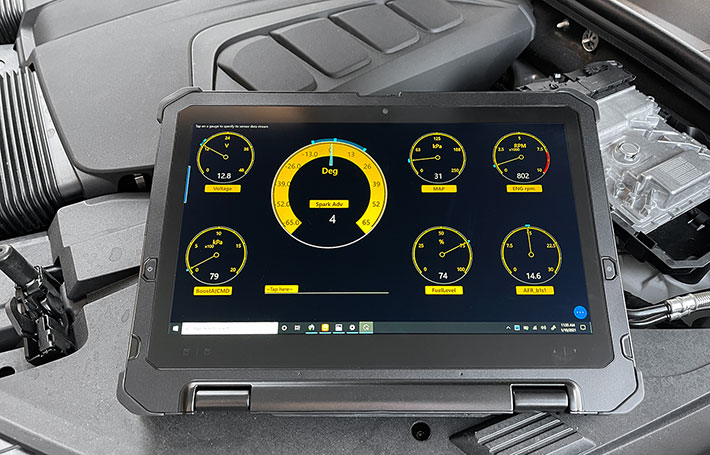
Design and construction
When it comes to design, what you see isn't always what you get. Materials may look like metal, carbon fiber, leather or whatever, but that may not be so. Sometimes what looks like a tough, solid, high-quality product isn't. That's why we open up and sometimes completely disassemble the rugged computing products we review. With the LT330 that's hardly necessary. It's the real thing. Pretty much the entire laptop is magnesium-aluminum alloy. There's some ABS + PC plastic, the rubber bumpers and glass. Everything is as solid and straightforward as it gets.
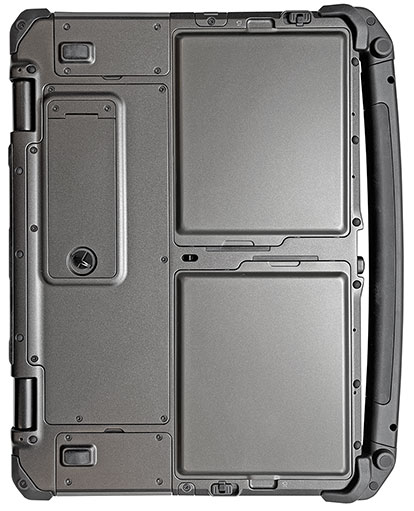 The picture to the right shows the backside of the LT330 convertible laptop. There are the two batteries, visible and easy to swap and replace. The standard batteries pack 61.6 watt-hours each, the optional high-capacity ones 91.2 watt-hours each. The picture to the right shows the backside of the LT330 convertible laptop. There are the two batteries, visible and easy to swap and replace. The standard batteries pack 61.6 watt-hours each, the optional high-capacity ones 91.2 watt-hours each.
DT Research is a strong believer in plenty of onboard battery power, and the LT330's combined 123.2 watt-hours is a more than in just about any other rugged laptop. And the optional 192.4 watt-hours, is way, way more.
The extended batteries stick out a bit, perhaps 3/8th of an inch whereas the standard batteries fit into the backside of the laptop. Each extended battery weighs a full pound, more than an entire iPad. Each easily snaps into the tablet, securely held in place by a spring-loaded, lockable lever.
The backside includes three removable covers. The two smaller ones cover the computer's two primary I/O areas. Why does one need access to those? There may be several reasons. I/O ports are notoriously difficult to seal. So combining I/O onto a small module board means there's only a single ribbon cable opening to seal, greatly reducing the danger of flooding the interior of the computer. Should one of the I/O compartments flood, it's easy to take the cover off and dry it, or replace it if need be. Finally, this design approach makes it easier for the manufacturers to offer custom I/O configurations.
The large cover has a smaller quick-release door in it that can be opened without tools in seconds. That makes it possible to remove the small 1x3 inch PCIe NVMe primary storage module, something that is becoming mandatory in many security-sensitive settings. Not everyone needs that quick access, and so the LT330 comes with a seal over the opening that can be removed.
Remove the large cover by undoing eight small screws and you have full access to the relevant parts of the laptop's motherboard. That includes both RAM memory slots, a SIM card slot, a second SSD mass storage module connector, and a half-size PCIe module slot for additional expansion.
As we had already found with the company's 14-inch DT340T and the smaller DT301 tablet, pretty much the entire system is solid magnesium-aluminum alloy. We're not talking the lightweight, fragile kind of metal structure sometimes found in premium consumer tablets. Below you can see the back of the LT330 with access panels, batteries, and protective doors removed.
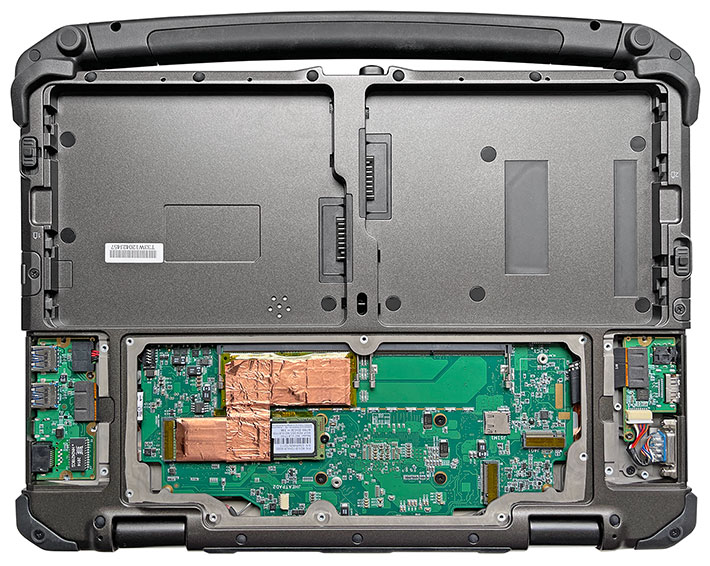
The LT330 is definitely not your generic laptop design. Everything is custom and as complex and refined as it needs to be to get the job done. Compared to sealing tablets, sealing laptops is much more complicated. Semi-rugged laptops rarely offer more than IP52 or IP53 protection, and offering full IP65 ingress protection is quite an achievement.
Note that the LT330 is a fanless design that doesn't have a cooling fan. For the most part that's a big plus as fans can be noisy and distracting, and they are also prone to clogging up and failing. The absence of a fan, however, means that there must be an alternate cooling strategy. That's often done with heat pipes that distribute the heat away from the hot electronics so they can safely dissipate. We didn't see any of those in the LT330 either, and so it's likely that the laptop's heavy metal case acts as heat sink and heat disseminator.
We used our FLIR One IR thermal imaging camera to show the LT330's heat flows and heat dissipation. The images below seem to confirm that the metal case of the LT330 itself acts as the heat sink. The bright yellow area is where the processor and ancillary electronic generate heat, and from there it gradually tapers down throughout the case. Under full load, the LT330 can get fairly hot at the source of the heat, and that may result in peak performance dropping off.
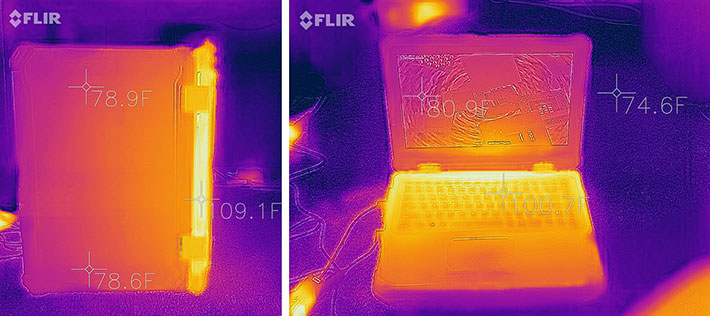
Below another look at the LT330's double-jointed display hinge system that makes laptop/tablet convertible functionality possible. It's ingenious in its simplicity. As much as we like the rotating center hinge used in many other laptop convertible designs, one of that solution's drawbacks is that it makes the LCD case wobbly when you use the machine as a laptop, especially when tapping the touch screen. The LT330's double hinge solution almost eliminates that problem (there remains a little give).

Keyboard and touch pad
The DT Research LT330's keyboard is full-scale and has 86 keys. The key design is standard "island" style with flat keys and minimal travel but good tactile feedback, as is common in today's notebooks and even desktop keyboards.
The central QWERTY layout is 100%-scale, which means the distance between the center of the Q key on the left and the P key on the right is 6.75 inches. That makes it perfect for touch typists. The keys are black with white letters, numbers and symbols. The keyboard has red LED backlight with brightness adjusted in seven steps via a keyboard function key.
Below the keyboard is the unit's 4 x 2 inch capacitive touch pad. It is a properly sized (not too small, not too large) touch area with a slight frame around it so your fingers feel the extent of the pad, and with two large mouse buttons in front of it. The mouse buttons require a relatively firm press and issue an audible mechanical click. The touch pad is very responsive and easy to use, and it can even be operated with gloves on (as long as they are not too thick).
Below you can see a close-up of the LT330 keyboard on the left, and a picture of the display and backlit keyboard in total darkness.
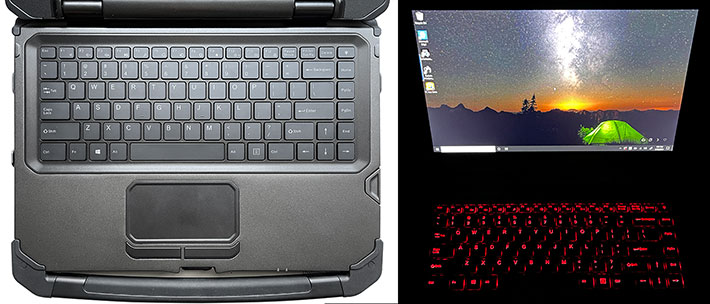
The keyboard includes a full row of F1 to F12 function keys, Windows shortcuts, media controls, screen brightness and volume up and down, and the usual PC functions. The power/sleep hardware button is on the LCD display keys where there is also a Night Vision/normal brightness toggle hardware button.
Powered by Intel 10th Generation "Comet Lake" Core processors
One of the challenges facing makers of rugged laptops is keeping customers happy without making them replace all of their machines every time Intel releases newer, faster, and better processors, which is often. Yes, rugged platforms can be "refreshed" by putting the latest chips into a proven design, but that comes at a cost, and at some point constant upgrading may no longer be worth it. So it's important to start out with state-of-the-art technology under the hood, and DT Research has done just that.
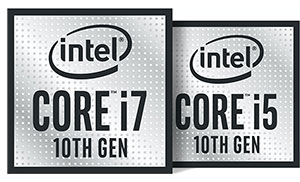 That was made possible by picking a pair of chips from Intel's 10th generation of Core processors, the first ever to offer not just quad-core configurations in ultra-low voltage mobile CPUs, but even a few chips with six cores and 12 threads. That was made possible by picking a pair of chips from Intel's 10th generation of Core processors, the first ever to offer not just quad-core configurations in ultra-low voltage mobile CPUs, but even a few chips with six cores and 12 threads.
That ongoing miniaturization, which enabled Intel to put more and more transistors onto a chip, has slowed down quite a bit, with most of the progress now coming from optimization between, and sometimes within, generations. As a result, the 10th generation of Core processors is anything but homogenous. Code names such as "Amber Lake," "Ice Lake," and "Comet Lake" are all being used for "10th generation" chips.
Each of those many code names and generations added and improved features and capabilities to a lesser or more noticeable extent. The biggest step forward probably was the move from dual-core to quad-core designs that happened in the 8th generation, and then the addition of hexa-core designs. Four cores can do more than two cores, and six more than four, and this allowed Intel to lower the base clock speeds of these chips, cutting down power consumption and heat generation. The ongoing refinements, on the other hand, allowed raising maximum "turbo" clock speeds higher. The overall result is higher peak performance with an overall power draw that's no more (and sometimes less) than it was with less powerful dual-core processors.
|
Available DT Research LT 300 CPUs
|
Intel Core i7
|
Intel Core i5
|
|
Model
|
10710U
|
10210U
|
|
Cores/Threads
|
6/12
|
4/8
|
|
Base Clock Speed
|
1.10 GHz
|
1.60 GHz
|
|
Turbo Speed
|
4.70 GHz
|
4.20 GHz
|
|
Thermal Design Power (TDP)
|
15 watts
|
15 watts
|
|
Smart Cache
|
12MB
|
6MB
|
|
Integrated graphics
|
UHD Graphics
|
UHD Graphics
|
|
Graphics base speed
|
300 MHz
|
300 MHz
|
|
Graphics max speed
|
1.15 GHz
|
1.10 GHz
|
|
Relative CPU cost
|
1.49
|
1.00
|
|
Intel Thermal Velocity Boost
|
No
|
Yes
|
Now let's look at how DT Research took advantage of this new Intel technology. LT300 Series customers have their choice of two state-of-the-art "Comet Lake" Intel 10th generation i5 and i7 Core processors.
One is the Core i7-10710U hexa-core chip with 12 threads, and the other the Core i5-10210U quad-core processor with eight threads. Both have a thermal design power of 15 watts, which is generally the highest heat load you'd want to have in a mobile device.
Thermal Design Power, by the way, is an Intel measure that says how much heat a computer must be able to handle and dispose of when using a given chip.
Both of these processors offer plenty of performance. Note that the high-end i7-10710U with its extra computing cores and threads can afford to idle along at a very low clock speed and still effortlessly get routine jobs done, all the while needing very little battery power. Under maximum load, there's turbo speed up to 4.7GHz. With fewer cores and threads, the lower-end Core i5-10210U needs a higher base clock speed, and maxes out at 4.20GHz.
To see how the DT Research LT330 convertible laptop performs compared to the company's own high-powered DT340T tablet, as well as high-performance rugged laptop competitors from Dell, Durabook, Getac and Panasonic, we ran our standard Passmark Software PerformanceTest 6.1 and 9.0, benchmark suites that run dozens of tests covering CPU, 2D graphics, 3D graphics, memory, and disk. The software then computes scores for each category and overall PassMark scores. We also ran the older CrystalMark benchmark that gives an indication of single core performance. The results are as follows:
|
Benchmark Overview
|
|
PERFORMANCE COMPARISON
|
DT Research
|
DT Research
|
Dell
|
Durabook
|
Getac
|
Panasonic
|
|
Model
|
LT330
|
DT340T
|
5420
|
Z14I
|
B360
|
FZ55
|
|
Type
|
Convertible laptop
|
2-in-1 Tablet
|
Laptop
|
Laptop
|
Laptop
|
Laptop
|
|
Year tested
|
2021
|
2019
|
2018
|
2020
|
2019
|
2019
|
|
Processor Type
|
Intel Core
|
Intel Core
|
Intel Core
|
Intel Core
|
Intel Core
|
Intel Core
|
|
Processor Type: Intel
|
i7-10710U (G10)
|
i7-8550 (G8)
|
i7-8650 (G8)
|
i7-8550 (G8)
|
i5-10210U (G10)
|
i5-8365U (G8)
|
|
Code name
|
Comet Lake
|
Kaby Lake R
|
Kaby Lake R
|
Kaby Lake R
|
Comet Lake
|
Whiskey Lake
|
|
Thermal Design Power
|
15 watts
|
15 watts
|
15 watts
|
15 watts
|
15 watts
|
15 watts
|
|
CPU Clock
|
1.10GHz
|
1.80GHz
|
1.90GHz
|
1.80GHz
|
1.60GHz
|
1.60GHz
|
|
CPU Turbo
|
4.70GHz
|
4.00GHz
|
4.20GHz
|
4.00GHz
|
4.20GHz
|
4.10GHz
|
|
CPU Cores/Threads
|
6/12
|
4/8
|
4/8
|
4/8
|
4/8
|
4/8
|
|
Intel Graphics
|
UHD 10th gen
|
HD 620
|
HD 620
|
HD 620
|
UHD 10th gen
|
UHD 8th gen
|
|
PassMark CPU Mark 6.1
|
10,901.6
|
6,331.3
|
10,460.3
|
9,153.2
|
9,094.8
|
7,497.0
|
|
2D Graphics Mark 6.1
|
441.2
|
373.5
|
330.7
|
366.0
|
459.7
|
243.7
|
|
Memory Mark 6.1
|
2,508.1
|
1,269.0
|
2,653.8
|
2,343.3
|
1,859.9
|
1,238.5
|
|
Disk Mark 6.1
|
18,718.2
|
11,386.2
|
9,443.5
|
5,002.6
|
15,505.4
|
4,943.8
|
|
3D Graphics Mark 6.1
|
703.8
|
703.6
|
786.4
|
877.7
|
595.6
|
412.7
|
|
Overall PassMark 6.1
|
7,284.8
|
4,381.6
|
5,331.3
|
4,050.2
|
6,027.3
|
3,319.5
|
|
PassMark CPU Mark 9
|
9,333.0
|
8,356.6
|
8,141.7
|
9,405.7
|
8,555.3
|
8,876.3
|
|
2D Graphics Mark 9
|
720.9
|
673.1
|
680.9
|
795.6
|
701.3
|
645.1
|
|
Memory Mark 9
|
2,585.5
|
2,424.8
|
2,751.0
|
2,987.3
|
2,285.3
|
1,772.3
|
|
Disk Mark 9
|
24,611.5
|
26,684.2
|
9.885.9
|
4,752.6
|
22,388.8
|
5,183.1
|
|
3D Graphics Mark 9
|
1,194.6
|
3,908.5
|
1,219.3
|
1,364.6
|
1,105.2
|
1,053.6
|
|
Overall PassMark 9
|
3,948.8
|
4,434.2
|
3,665.6
|
3,935.8
|
3,629.8
|
3,155.7
|
|
Overall CrystalMark
|
336,613
|
324,314
|
281,820
|
313,175
|
299,539
|
288,678
|
The results show that the computing performance world stands still for no one. Anything high-end equipped with processors before Intel's 7th generation is no longer competitive. And that includes Panasonic's Toughbook 20, 31 and 33 that remain at the 7th generation. Though it's considered a semi-rugged, we included the results of the Panasonic Toughbook 55 instead.
Chip generation and the number of cores, however, are not all that matters. Other recent advances include the gradual migration from SATA-based mass storage to using the significantly faster PCIe NVMe interface. And when highest graphics performance matters, adding discrete graphics yields a very noticeable edge over Intel's integrated graphics. The DT Research DT340T 2-in-1 tablet, for example, did have NVIDIA GeForce GTX 1050 discrete graphics.
As is, the DT Research LT330 delivered blistering performance. With a Hexa-core processor and PCIe NVMe storage, and overall excellent implementation of state-of-the-art electronics, outscored every other mobile machine we've tested to date, and that with a silent, fanless design!
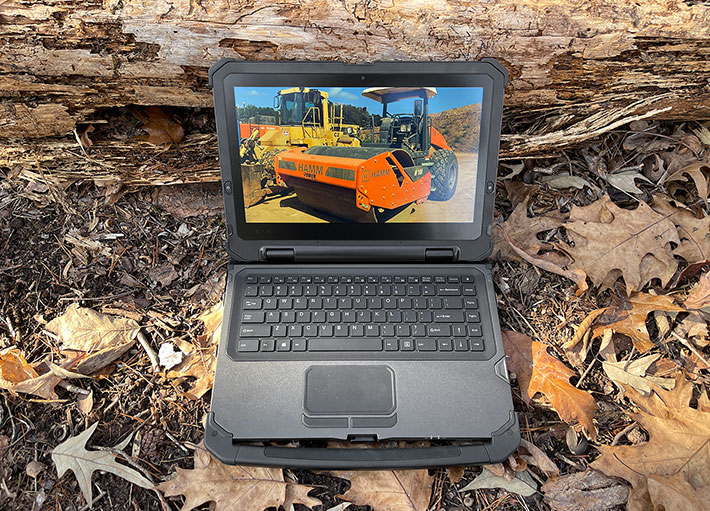
Power consumption: most impressive
What impact does the LT330's very high performance, hexa-core processor and its bright, vibrant screen have on power consumption and battery life? As is our standard procedure, we used Passmark Software's BatteryMon power management benchmark utility to measure the DT Research convertible laptop's power draw under various operating conditions.
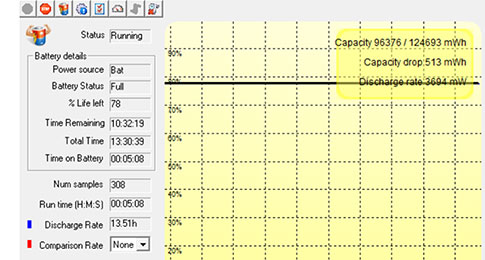 First we set the Windows 10 power options to "Best battery life" and display brightness to its lowest setting (0%). That way we saw an idle power draw of 3.7 watts. We then cranked the backlight up to 50%, and draw increased to 6.4 watts. Then we cranked brightness all the way up to 100% and saw 9.2 watts. That's with the tablet being awake, just idling along. First we set the Windows 10 power options to "Best battery life" and display brightness to its lowest setting (0%). That way we saw an idle power draw of 3.7 watts. We then cranked the backlight up to 50%, and draw increased to 6.4 watts. Then we cranked brightness all the way up to 100% and saw 9.2 watts. That's with the tablet being awake, just idling along.
Next we set the Windows 10 power options to "Best performance" and display brightness at its lowest setting (0%). That way we saw an idle power draw of 4.0 watts. We then cranked the backlight up to 50% and draw increased to 7.6 watts. Then we cranked brightness all the way up to 100% and saw 11.7 watts.
|
DT Research LT330 Power Draws
|
|
Backlight level
|
Lowest (0%)
|
50%
|
Maximum (100%)
|
|
Power Saver
|
3.7 watts (33.3 hrs)
|
6.4 watts (19.3 hrs)
|
9.2 watts (13.4 hrs)
|
|
Max Performance
|
4.0 watts (30.8 hrs.)
|
7.6 watts (16.2 hrs.)
|
11.7 watts (10.5 hrs.)
|
What do those power draw figures mean in terms of projected battery life? The two Li-Ion batteries of our review LT330 had a combined capacity of 123.2 watt-hours. Dividing that by the very modest 3.7 watt minimum observed draw would indicate a stellar 33.3 hours of battery life with the system staying awake the whole time. In the maximum performance settings and with the backlight going at 100%, theoretical battery life would drop to a still excellent 30.8 hours.
Those are excellent numbers and a testimony both to the power efficiency of Intel's new mobile hexa-core processors as well as to Window 10's power management and the DT Research engineers' design skills and optimized configuration settings.
And just in case that the theoretical 33 hours of battery life aren't enough, DT Research also offers extended 91.2 watt-hour batteries for a total 182.4 watt-hours!
Big, bright display
The LT330 convertible laptop's 13.3-inch display offers 1920 x 1080 pixel resolution, making for a wide-format 16:9 aspect ratio and 166 pixels per inch. That's not terribly high by today's smartphone and consumer tablet standards. Consider, though, that perceived sharpness depends on viewing distance. A 70-inch 4K TV looks very sharp when you sit eight or ten feet away in front of it, although it actually has just 63 pixels per inch. And the LT330 screen is considerably sharper than most current desktop monitors. It's all relativ. That said, given the high-end nature of this laptop, DT Research should consider offering a higher resolution display option.
Most laptop, tablet and smartphone screens on the market today are of the glossy variety. That makes for colors that pop but also for considerable reflections outdoors. That's not that much of an issue for tablets and phones because one can simply hold them so as to avoid reflections. With a heavy laptop that's not always so easy. That may be the reason why DT Research went with a semi-matte display or perhaps anti-reflective coating.
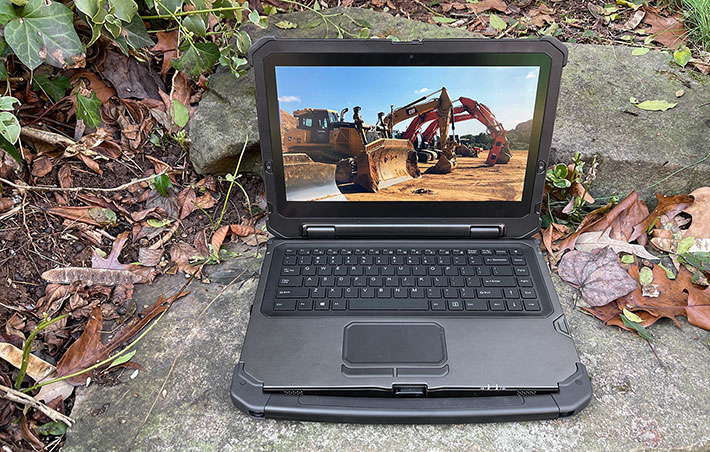
Not too many years ago, outdoor viewability was the weak point of most rugged mobile computing devices. Display technologies came and went, none yielding acceptable results. Eventually the industry decided that modifying conventional transmissive LCDs for daylight and sunlight use was the best available way to go.
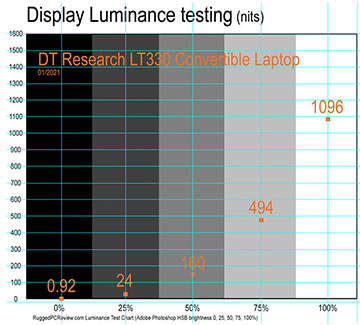 That's done by reducing the display's internal reflection of ambient light so that, in conjunction with a reasonably strong backlight, there is enough contrast to make the screen viewable outdoors. This reduction of internal reflection is accomplished via a combination of polarizers, filters, coatings and elimination of air spaces between the various layers of the LCD.
That's done by reducing the display's internal reflection of ambient light so that, in conjunction with a reasonably strong backlight, there is enough contrast to make the screen viewable outdoors. This reduction of internal reflection is accomplished via a combination of polarizers, filters, coatings and elimination of air spaces between the various layers of the LCD.
Almost all mobile devices use this technology today but the exact implementation varies from manufacturer to manufacturer. As does the strength of the backlight (a stronger backlight means a larger battery or shorter battery life).
DT Research has plenty of experience in this and it shows. The LT330 display is not only excellent indoors, it also remains very usable outdoors. The tablet's 1,000 nits (we measured 1096) backlight is plenty strong enough to boost contrast and viewability in broad daylight.
The table to the right shows our measurements of the light emitted by the LT330's display. The light emitted by a display backlight is given in a unit called candela per meter squared, or cd/m2, usually just called "nits." Standard laptops generate about 200 nits. A good tablet or smartphone between 500 and 600 nits. Some rugged laptops can generate as much as 1,500 nits, as can modern 4K HDR TVs.
Viewing angle is another display quality that we consider relevant in laptops. It's important because it's annoying of the screen image changes when you look at it from a different angle. What's on the screen must remain easily viewable regardless of the viewing angle, and there must not be any changes in color, contrast or brightness.
The LT330 display scores high in that regard. It offers near perfect horizontal and vertical viewing angles. Colors, and contrast remain true and unchanged when viewed from various angles.
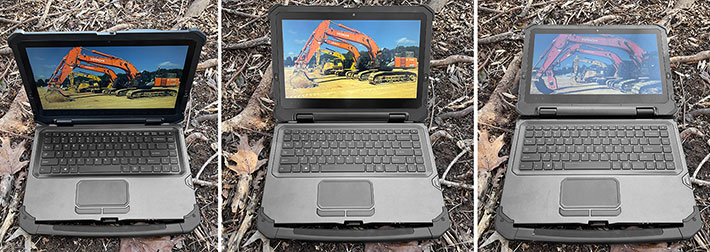
There is, however, a small price to pay for the reflection resistance of the LT330's semi-matte display technology: Outdoors, what would be reflections on a glossy display gets defused by the anti-glare features. That makes for slight milkiness and perceived brightness reduction. Overall, the display of the LT330 is about as good as it gets with current display technology.
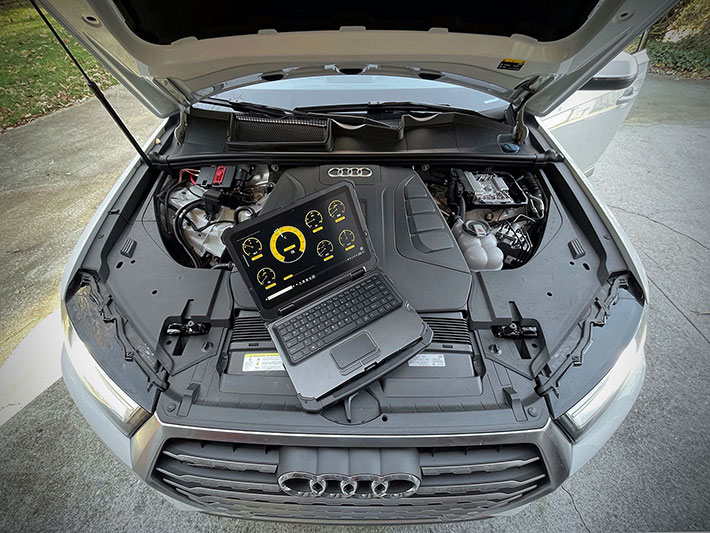
Ruggedness
The LT330 clearly is a tough and very rugged laptop. Its hefty and extremely solid construction alone see to that. However, do keep in mind that while a simple silicon sleeve can protect a smartphone from most harm, it's much more complex to shield a 7.5 pound laptop from impact damage. It's the same laws-of-physics thing that makes an ant able to lift several times its own weight where as infinitely stronger elephant can do no such thing.
As a result, don't look for the same long list of awe-inspiring ruggedness specs as you would for a two or three pound tablet. And don't expect to toss it onto the bed of a pickup truck, rattling around, and not emerge scratched up a bit. 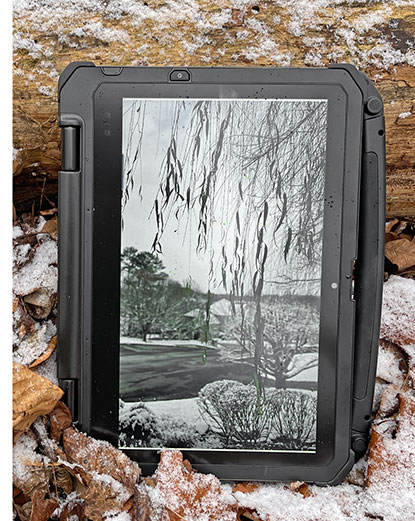 Given its solid, heavy ABS + PC plastics and magnesium-aluminum alloy construction it won't break, but physics are physics. Given its solid, heavy ABS + PC plastics and magnesium-aluminum alloy construction it won't break, but physics are physics.
Think of a Mercedes Benz G-Class Geländewagen. It can handle an awful lot and won't break. But it's big and heavy and you wouldn't want it all scratched up.
The specs state IP65 sealing, which means the device is fully protected against dust, and also protected against low pressure water jets from all directions, albeit with, according to the spec, "limited ingress permitted."
IP65 is pretty much the expected norm for ultra-rugged tablets in this class. In essence, IP65 here means you can use it in the rain, it won't mind sitting in a puddle or being washed off, but dropping it into a stream isn't a good idea. And do make sure the protective doors are closed when using the tablet in wet conditions.
The standard operating temperature range is a very wide -4 to 140 degrees, making the system deployable almost anywhere, including in commercial freezers. If that's not enough, DT Research offers a low temperature option that enables operation down to -22°F (-30°C).
DT Research also claims MIL-STD-810G/H testing for drop, shock and vibration.
Here it would be good to see more detailed information in the spec sheet and promotional materials. Customers are interested in rugged tablets because they can handle more abuse, so specific information on just how much abuse should be included. The tablet feels extremely solid and trust-inspiring, without, of course, any flex or creaking. That said, it would be good to know what sort of strengthened glass DT Research used and also what sort of scratch resistance the metallic surfaces provide.
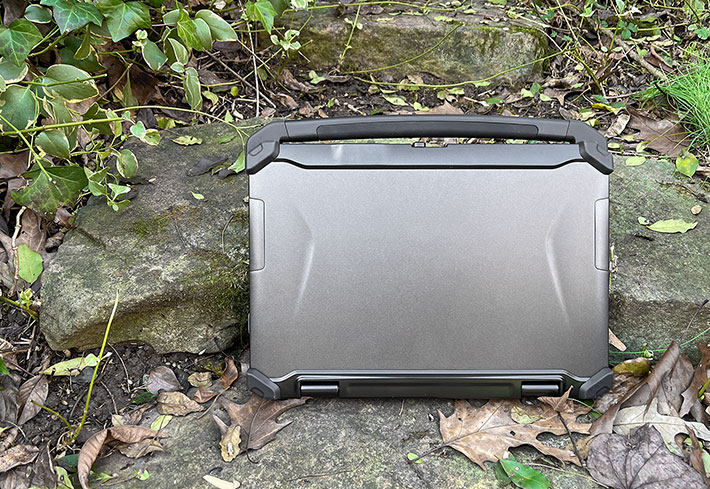
Summary: DT Research LT330 rugged convertible laptop
With the LT300 series of convertible laptops, DT Research enters the hotly contested market of rugged notebook computers, the kind used by law enforcement, first responders, and anyone else who needs a tough, solid laptop for use on the road and in the field. These, however, are not your standard laptops. They can also be used as tablets by simply flipping the screen around.
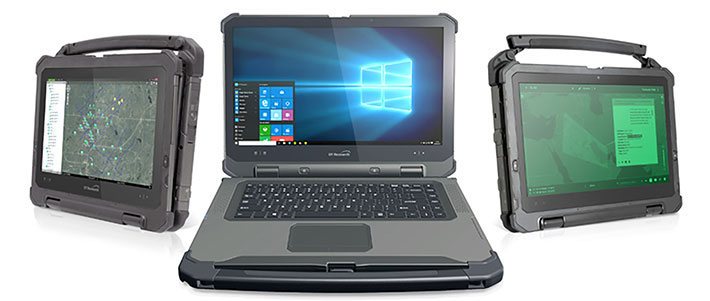
The 13.3-inch LT330 we tested comes with a very bright, daylight-viewable capacitive multi-touch display with full HD resolution, perfect viewing angles from all directions, and an optional active pen with a pencil-thin, pressure-sensitive tip.
The attractively designed magnesium-alloy laptop is tough, very well built, and well protected. An additional attraction in the pandemic times are the antimicrobial properties of the enclosure, inhibit the spread of microorganisms on the surface of the units. With its large screen and impressive build, however, the LT330 heavy, isn't a lightweight. It weighs around 7.5 pounds as tested.
Equipped with dual full-size USB 3.0 ports, a multi-purpose USB Type-C port, RJ45 LAN, HDMI, a legacy serial port, and a Smart Card/CAC reader, the LT330 can be custom configured with 4G LTE/AWS, discrete GNSS and front and back full-HD cameras.
The optional detachable full-scale keyboard converts the LT330 into a hybrid 2-in-1 device that can instantly provide full laptop functionality with additional connectivity.
Built on Intel 10th generation four-core and six-core processors, using fast PCIe NVMe storage and offering class-leading battery capacity, the well-conceived and well executed LT330 convinces with both excellent performance and long battery life. -- Conrad H. Blickenstorfer, January 2021
DT Research LT330 Specs:
| Status |
Added 01/11/2021, full review 01/11/2021
|
| Type |
Rugged convertible laptop
|
| Processor |
Intel 10th generation "Comet Lake" 6-core i7-10710U (1.1GHz, up to 4.7GHz turbo)
Intel 10th generation "Comet Lake" 4-core i5-10210U (1.6GHz, up to 4.2GHz turbo)
|
| Graphics |
Core i7-10710U: Intel UHD Graphics for 10th Gen Intel Processors (300MHz/1.15GHz)
Core i7-10710U: Intel UHD Graphics for 10th Gen Intel Processors (300MHz/1.10GHz)
|
| CPU Thermal Design Power |
Both 15 watts |
| OS |
Microsoft Windows 10 IoT Enterprise
|
| Memory |
8GB to 64GB RAM in two slots
|
| Display |
Sunlight-readable TFT with LED backlight, 1,000 nits (measured 1,096 nits); optional 800 nits night vision screen with 0 to 20 nits NVIS mode
|
| Display Size/Resolution |
13.3-inch/1920 x 1080 pixel FHD (166 ppi) |
| Digitizer |
Capacitive multi-touch, optional eGalaxPen active pen with replaceable 1.5mm tip (uses AAAA battery) |
| Keyboard/buttons |
100%-scale 86-key keyboard with full row of F1 to F12 function keys, Windows shortcuts, media controls, screen brightness, 1 power button, 2 programmable buttons, 2 brightness control buttons, 1 NVIS/Normal toggle |
| Navigation |
Touchpad, keyboard, stylus, optional mouse |
| Storage |
256GB to 4TB SSD in two slots, supports quick release and RAID 0/RAID 1 (sample unit had 1TB Samsung PM981 Series M.2 2280 PCIe NVMe SSD)
|
| Expansion slots |
1 x micro SD card, full-slot Smart Card/CAC reader, SIM card |
| Housing |
Antimicrobial ABS + PC plastics and magnesium-aluminum alloy
|
| Size |
1.5 x 13.6 x 9.7 inches (39 x 345 x 247 mm)
|
| Weight |
7.5 lbs. (3.4kg) with two batteries
|
| Operating temperature |
14° to 140°F (-10° to 60°C), optional -30°C to 60°C (-22°F to 140°F)
|
| Ingress protection |
IP65 |
| Altitude |
unknown
|
| Drop/shock |
MIL-STD-810G/H |
| Vibration |
MIL-STD-810G/H |
| Humidity |
0% to 90% non-condensing |
| Regulatory |
FCC Class B, CE, RoHS compliant |
| Power |
2 x hot-swappable 11.4V 5,400mAH Li-Ion (61.6 watt-hour) for 123.2 watt-hour total, optional 2 x hot-swappable 11.4V 8,000mAH Li-Ion (91.2 watt-hour) for 182.4 watt-hour total
|
| Cameras |
Optional front and back full-HD cameras with auto white balance and gain/exposure control enable facial recognition security
|
| Interface |
2 x USB 3.0, 1 x USB Type-C (for data transmitting, video-out, and charging), 1 x HDMI, 1 x RJ45, 1 x DB9 RS232, power
|
| Wireless options |
802.11ac WiFi, Bluetooth 4.2 LE; optional 4G LTE/AWS mobile broadband, u-Blox M8 GNSS (GPS and GLONASS)
|
| Price |
Inquire |
| Product page |
LT300 rugged laptops web page and LT330 product page |
| Spec sheet |
 LT330 brochure (PDF) LT330 brochure (PDF)
|
| Warranty |
1, 2, or 3 year extended or no-fault options
|
|
Contact
|
DT Research
2000 Concourse Drive
San Jose, CA 95131, USA
Tel: (408) 934-6220
Fax: (408) 934-6222
Web: www.dtresearch.com
|
(copyright 2021 RuggedPCReview.com)
|






